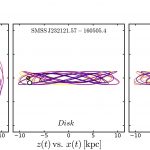Orbits of ancient stars prompt rethink on Milky Way evolution0
- From Around the Web, Space
- November 18, 2020
Theories on how the Milky Way formed are set to be rewritten following discoveries about the behavior of some of its oldest stars.

Theories on how the Milky Way formed are set to be rewritten following discoveries about the behavior of some of its oldest stars.

There are at least 300 million habitable planets in the Milky Way, new NASA research has shown – hinting that it’s less likely that humanity is alone in the universe.

Most stars in the central 1,000 light-years of the Milky Way’s hub formed when it was swollen with infalling gas more than 10 billion years ago, according to astronomers from the Blanco DECam Bulge Survey.

First fast radio burst found in our galaxy is traced to magnetar 30,000 light years away

Astronomers have discovered a planetary free agent floating through the Milky Way, unbound to the gravity of any nearby stars. The discovery, detailed Thursday in Astrophysical Journal Letters, suggests the Milky Way may be teeming with rogue planets.

Astronomers get to the heart of the Milky Way.

The Milky Way’s core harbors two giants: the galaxy’s largest black hole and a cluster of tens of millions of stars around the black hole that is denser and more massive than any other star cluster in the galaxy.

Weirdly, the biggest part of a galaxy is the hardest thing to see in it.

Using a clever gravity trick, researchers locate a distant galaxy reminiscent of our own. Current theories say it shouldn’t be there.

The new technique could map the velocity of gas in the towering structures called Fermi bubbles